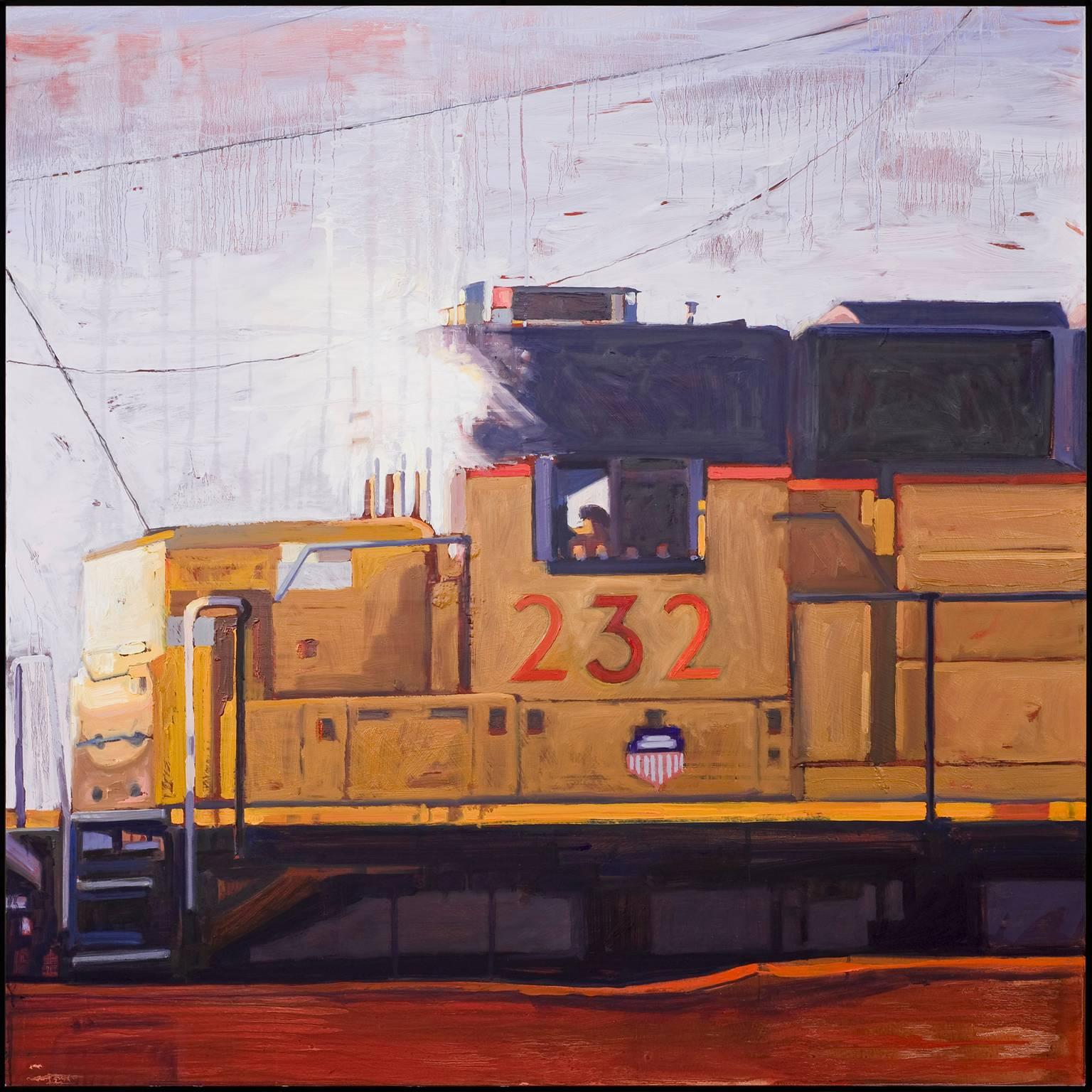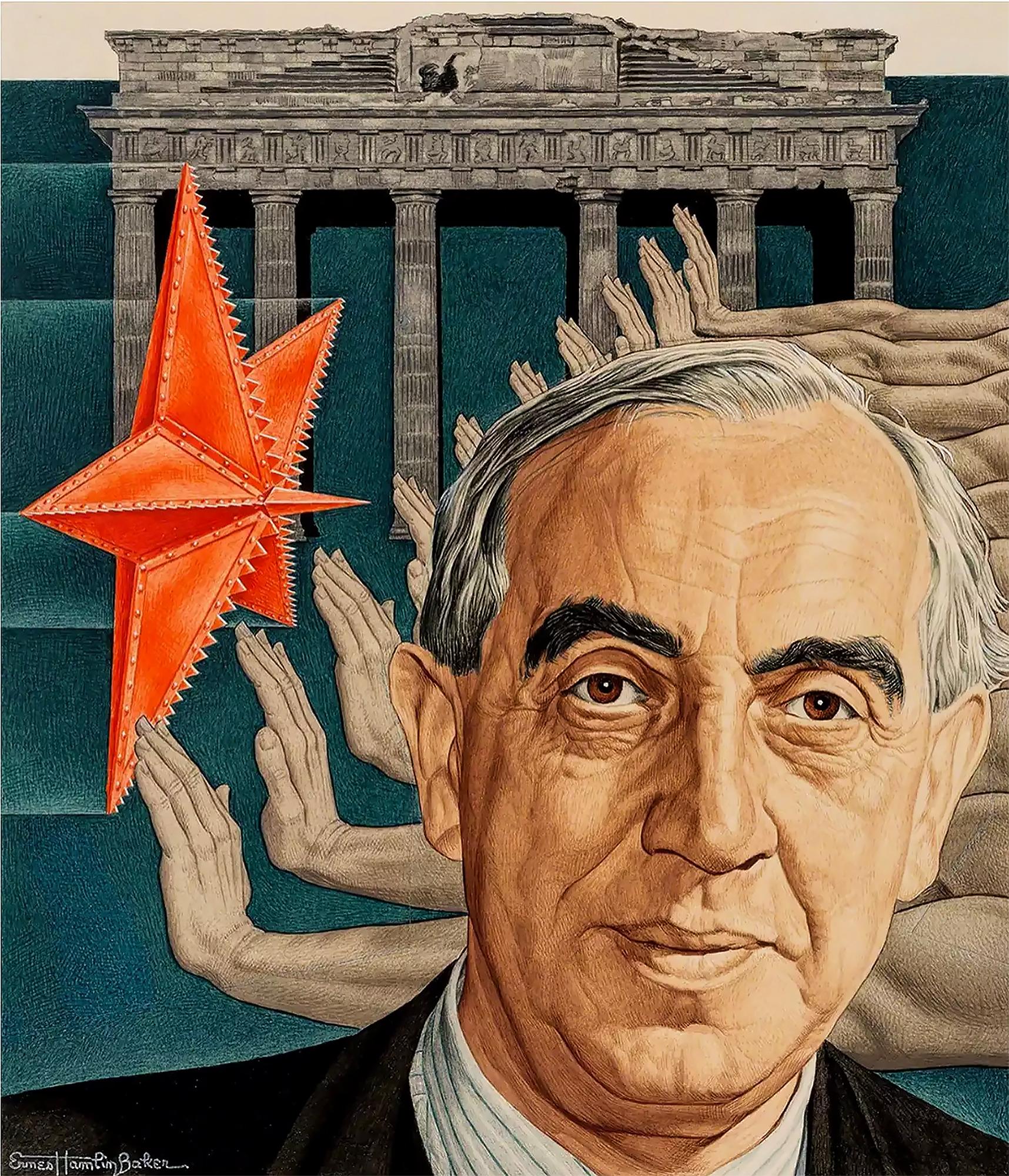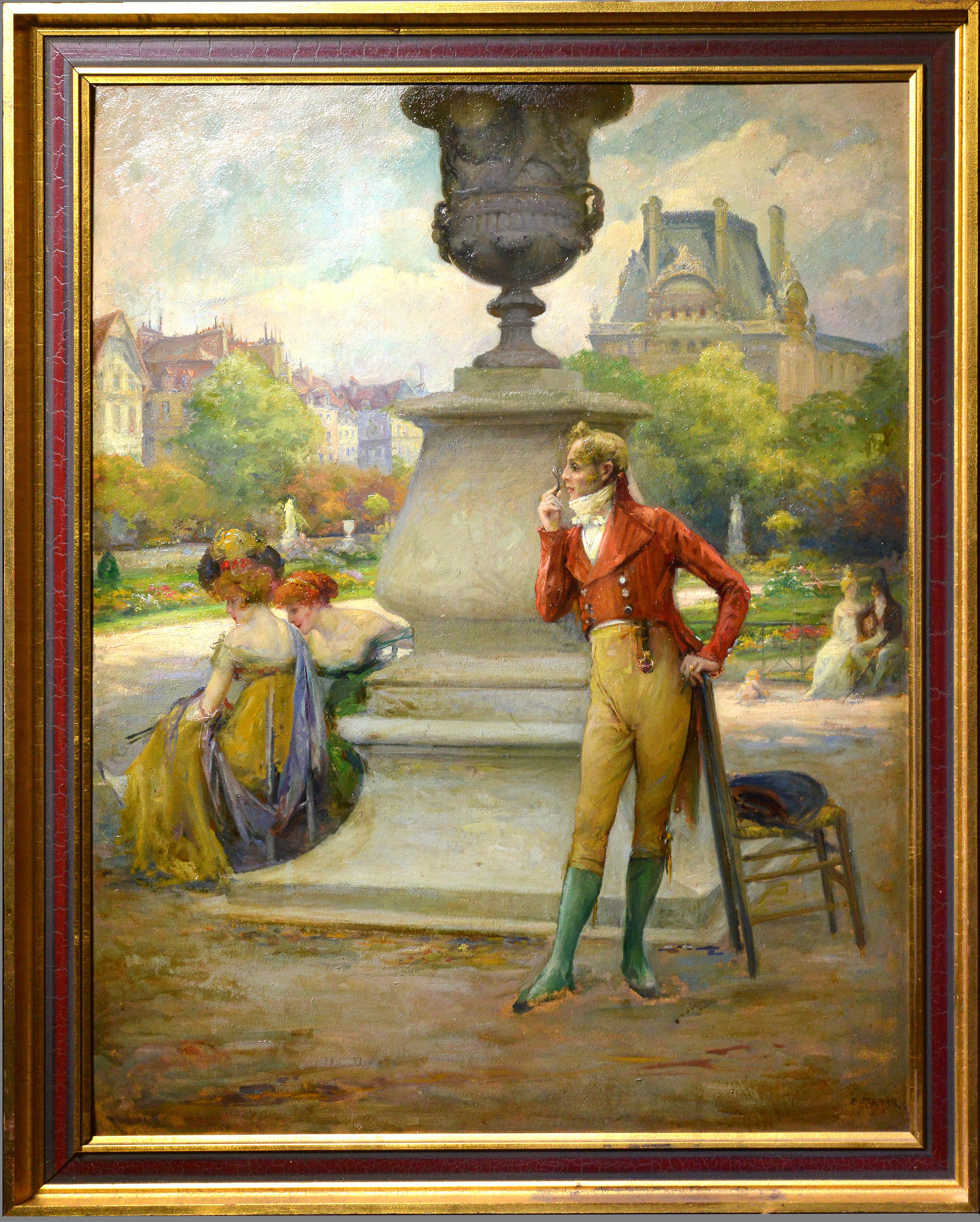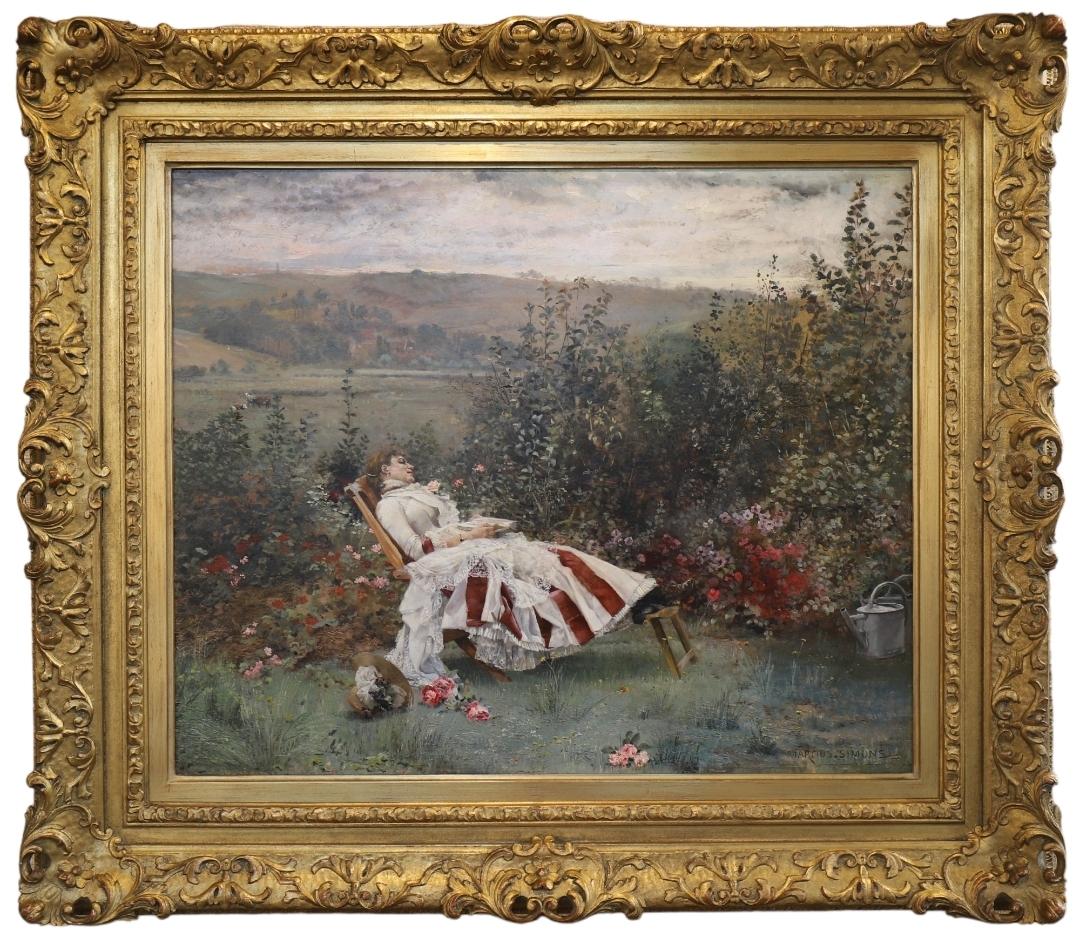Items Similar to "Child in an American Landscape" James Gantt, Midwestern Regionalism, Missouri
Want more images or videos?
Request additional images or videos from the seller
1 of 12
James Gantt"Child in an American Landscape" James Gantt, Midwestern Regionalism, Missouri1940
1940
About the Item
James Britton Gantt (1911 - 1984)
Child in an American Landscape, 1940
Egg tempera on board
17 1/2 x 14 inches
Signed and dated lower right
Provenance:
Private Collection, San Francisco
Regarding this painting, the artist's daughter said, "The subject matter of your painting reflects my father's propensity for presenting minority figures with dignity, as well as an admiration for the contributions of hard-working people. The painting's background packs in details reminiscent of the technique he used working on mural projects."
Painter, printmaker, muralist. Born in Lawrence, Douglas County, Kansas (some sources wrongly indicate Kansas City), the son of Euphemia Lane Fox Blackburn (1883 – 1929) and Charles Whittle Gantt (1881 – 1952). He was the grandson and namesake of Judge James Britton Grant (1845 – 1912), a former Chief justice of the Supreme Court of Missouri. His father, Charles, though trained as a lawyer, suffered from alcoholism and instead worked for the railroad.
James Gantt was just two years old when his alcoholic father abandoned him, and still young when his mother contracted tuberculosis and had to enter a sanatorium. A wealthy aunt stepped in to finish raising the boy and saw to his education, but when Gantt was a teenager his mother tried to regain custody, and he ran away from home. After some time roaming in the country working odd jobs [including working on farms, punching cattle, working in a circus, washing dishes and working as a movie stunt man], his artistic talent always in evidence, he enrolled in the Dallas Art Institute.
He eventually settled in Texas, where in 1933, at the age of twenty-two, he enrolled as a scholarship student at the Dallas Art Institute under the painter and director of the Institute, Olin H. Travis (1888 – 1975). Due to his continued lack of funds, the following year Travis helped Gantt apply for and receive a scholarship to study at the Kansas City Art Institute in Kansas City, Missouri. He began his studies there with the modernist landscape painter Ross E. Braught (1898 – 1983) followed by a full year of study with the famous regionalist painter and muralist, Thomas Hart Benton (1889 – 1975).
Following his graduation from the Kansas City Art Institute he joined Benton as an apprentice, working alongside the master on his preparations for Benton’s murals for the Missouri State Capitol Building in Jefferson City, Missouri. The two became even closer due to their shared love of jazz music, which Gannt had come to adore during his youth. When Benton was fired by the Art Institute in 1939, it was Gantt and other alumni who helped organize the defense of their professor.
Gantt began exhibiting his own paintings regularly during the 1930s and was a routine participant in the Kansas City Art Institute’s major annual, the “Midwestern Artist’s Exhibition.” His first solo was held at Miss Effie Seachrest’s Little Galley in Kansas City, where he showed drawings paired with three-dimensional works by John Wisely. Reviewers took note: “The drawings by James Gantt… are curiously interesting. A fine nude demonstrates good draughtsmanship and a few abstractions display a feeling for rhythm. The young artist obviously is interested in mystical trends. Ozark Sketches in black and white and a glimpse in color of an Ozark home are among his exhibits.”
He also exhibited alongside fellow Benton acolytes in the Kansas City Art Institute’s 1936 “Thomas Hart Benton and His Students Exhibition,” where his works were mentioned in reviews of the show:
“James B. Gantt’s farmyard painting of a familiar problem of milking time inherits a sense of design from the right sources, but the average visitor hardly will notice that, for he will be torn between amusement at the joke the young farmer is playing on the calf and sympathy for the cows cheated off-spring straining at the rope by which he is tied to the fence post. The young farmer in his blue jeans calmly milks the cow. It is the calf that makes all the fuss an incidentally provides the hunger-drama for the picture. Mr. Gantt also has a good plowing scene.”
At Holiday time Gantt participated in Mrs. Thomas H. Benton’s “Midwestern Art for Midwesterner Homes Exhibition” in the Circle Building, where he was remarked as being “represented by admirable work.” That same year he married Hattie Naomi Moore (1910 – 2006), whom he had met at the Kansas City Art Institute where she was studying sculpture with William W. Rosenbauer (1900 – 1968) and painting with Thomas Hart Benton.
In 1937 Gantt was selected by the First Visitation Catholic Church in Kansas City to create and mural cycle for their house of worship based upon the theme of the life of Christ. The mural was designed as a sixteen-panel installation and was mostly completed by July of that year. It was noted at that time that Gantt “from the first has displayed promising originality… there is a grasp of great ideas in his work and unusual maturity and independence.”
He continued to show in regular exhibitions at the Kansas City Art Institute, including in the 1937 Annual “Sweepstake Exhibition,” where his work “Arcadia – Mortgaged” was remarked as being “out of the ordinary.” By 1938 he was employed by the Federal Art Project and was being considered for the commission to create murals to decorate the City Hall Auditorium in Kansas City, Kansas. Gantt created extensive cartoons for its creation, but in the end, he was rejected for the commission. According to a local historian it is “speculated the reason for this was because the political party in power objected to the labor images included in the murals.” The cartoon drawings for the proposed mural were exhibited at Midwestern Galleries in Kansas City, Missouri, that same year.
Gantt was awarded a solo exhibition of his paintings in early 1939 at the Art Institute’s Downtown Gallery in Kansas City and was one of a number of prominent artists to be selected to represent Missouri and the Midwest at the 1939 New York World's Fair held in Flushing Meadows, Queens, New York. At the fair, he exhibited the painting “Kansas Pastoral,” which was remarked upon in the press as depicting a picture of “human love as a phenomenon of no interest to farm beast or fowl. The environment looks familiar to any midwesterner, even though the sweethearts go unrecognized.” The 1939 “Sweepstake Exhibition” at the Kansas City Art Institute led Gantt to a first prize for a portrait head of his wife, with a reviewer remarking “Of the painters that have come out of the Art Institute in the last few years, my vote now goes for Gantt as the one most likely to succeed.”
In 1941 forty of Gantt’s paintings were show in a solo exhibition at the Woman’s City Club in Kansas City, where a reviewer noted “None of our younger artists have worked, in my opinion, has worked more sincerely and more persistently than Gantt.” By 1942 Gantt was a Works Progress Administration (W.P.A.) Art Supervisor overseeing a display of civilian defense exhibits at the civilian defense fair in North Kansas City. His last recorded submission to a major show was the 1945 opening exhibition of the Little Gallery at the University of Kansas City, Missouri, where he exhibited “The Circus.”
Following that time, Gantt began to work for major corporations as a design and promotional manager. In 1947 he joined the Coleman Company Inc., in Wichita, noting he was formerly a “professional photographer, commercial artist, radio producer and advertising copyrighter.” He remained with Coleman until 1954 when he was appointed advertising and sales promotion manager of James, Inc., a dishwasher manufacturer in Independence, Kansas. Later Gantt worked in Memphis, Tennessee as the promotions director for the Memphis Chapter of the Foundation for World Literacy before moving to Milwaukee, Wisconsin to work for the Batchelder Company.
James Britton Gantt died in Milwaukee, Wisconsin on Tuesday, the 21st of August 1984 at the age of seventy-two years. His burial location remains unknown.
As a painter, James Gantt mirrored a love for rural America that was espoused by his friend and mentor, Thomas Hart Benton. His works reflect Benton’s teaching and artistic style and honor his own experience of wandering across the America of the Great Depression, working odd jobs just to get by. As Gannt once remarked: “I paint only what I have lived and experienced, what I know from the ground up.” His production period appears to have been quite short, c. 1933-1947, indicating a need to have a steady income to help support is wife and three daughters.
In addition to his painting work, Gantt was a regular contributor of illustrations to the jazz magazine Swing Time. Neither he nor his wife taught but Gantt did write an unpublished memoir (location today unknown). Together they became known for their extensive collection of jazz records as well as their collection of 13th and 14th century Italian and 16th century Spanish art that was noted as being “part of one of the most extensive private collections in the Middle West.”
Though there are undoubtedly other exhibitions in which Gantt participated, those presently known include the following: Seachrest’s Little Galley, Kansas City, MO, 1935 (solo with John Wisely); Kansas City Art Institute, Kansas City, MO, 1936-40, 1941 (prize); Thomas Hart Benton and His Students, Kansas City Art Institute, Kansas City, MO, 1936; Mrs. Thomas H. Benton’s Midwestern Art for Midwesterner Homes Exhibition, Circle Building, Kansas City, MO, 1936; 4th Annual Sweepstake Exhibition, Kansas City Art Institute, Kansas City, MO, 1937, 1939 (prize); 50th Anniversary Student Exhibition, Kansas City Art Institute, Kansas City, MO, 1937; Thomas Hart Benton Student Exhibition at the Association of American Artists, New York, NY, 1937; Midwestern Galleries, Kansas City, MO, 1938 (solo, Kansas City, KS, Mural Drawings); The Art Institute’s Downtown Gallery, Kansas City, MO, 1939 (solo); World’s Fair, Flushing Meadows, NY, 1939; Woman’s City Club, Kansas City, MO, 1940, 1941 (solo); Little Gallery, University of Kansas City, MO, 1945; Franklin Riehlman Fine Art, New York, NY, 2008 (retrospective); Modern Dialect: American Paintings from the John and Susan Horseman Collection Traveling Exhibition, various U.S. locations, c. 2012-15; Painted Black: The John Surovek Collection, Museum of Art – DeLand, Deland, FL, 2015.
- Creator:James Gantt (1911 - 1984, American)
- Creation Year:1940
- Dimensions:Height: 21 in (53.34 cm)Width: 19 in (48.26 cm)
- Medium:
- Movement & Style:
- Period:
- Condition:
- Gallery Location:New York, NY
- Reference Number:1stDibs: LU1841210021642
About the Seller
5.0
Platinum Seller
These expertly vetted sellers are 1stDibs' most experienced sellers and are rated highest by our customers.
Established in 2021
1stDibs seller since 2022
63 sales on 1stDibs
Typical response time: <1 hour
- ShippingRetrieving quote...Ships From: Larchmont, NY
- Return PolicyA return for this item may be initiated within 3 days of delivery.
More From This SellerView All
- "Portrait of a Woman, " Leon Kroll, Mid-Century American RealismBy Leon KrollLocated in New York, NYLeon Kroll (1884 - 1974) Portrait of a Woman, circa 1950 Oil on canvas 20 3/4 x 17 inches Signed lower left Provenance: Private Collection, New York Private Collection, North Caroli...Category
1950s American Realist Portrait Paintings
MaterialsCanvas, Oil
- "Scribbler in Autumn" Modernist, Figures in Landscape, Abstract elementsBy Helen West HellerLocated in New York, NYHelen West Heller Scribbler in Autumn, 1952 Monogrammed and dated lower left; signed, titled and dated on the reverse Oil on board 47 x 38 inches After growing up close to nature a...Category
1950s Figurative Paintings
MaterialsOil, Board
- "Factory on the River, " Modernist and Precisionist WPA Industrial New York SceneBy William SharpLocated in New York, NYWilliam Sharp (1900 - 1961) Factory on the River Oil on canvas 17 1/2 x 23 1/4 inches Initialed lower right: WS Provenance: Estate of the artist Private Collection, New York Swann Auction Galleries, American Art, June 13, 2019, Lot 178 William Sharp was born on June 13, 1900, in Lemberg, Austria, where he attended college and the Academy for Arts and Industry. He later studied in Kraków, Poland, and in Berlin and Munich, Germany. Sharp began his career as a designer of stained-glass windows and as a painter of murals. He served in the German army during World War I. After the war he became a newspaper artist in Berlin and a well-known etcher. Sharp drew political cartoons that were bitterly critical of the growing Nazi movement. As the influence of National Socialism intensified, he began to contribute drawings, under a pseudonym, to publications that were hostile to Hitler. After Hitler assumed power, Sharp was confronted with these drawings and told that he would be sent to a concentration camp. However, in 1934, he escaped to the United States. His first newspaper assignment in America was making courtroom sketches for The New York Mirror...Category
Mid-20th Century American Realist Landscape Paintings
MaterialsCanvas, Paint, Oil
- "Colonial Sand and Stone Company, New York, " Industrial WPA Scene, PrecisionistBy William SharpLocated in New York, NYWilliam Sharp (1900 - 1961) Factory on the River Oil on canvas 20 1/2 x 28 1/2 inches Initialed lower left: WS Provenance: Estate of the artist Private Collection, New York Swann Auction Galleries, American Art, June 13, 2019, Lot 178 Private Collection, New York Colonial Sand and Stone Co., founded by Generoso Pope, was once the country’s largest sand and gravel business, providing the concrete for much of New York City’s skyline, including the Empire State Building, Rockefeller Center, Radio City Music Hall, airports and subways. William Sharp was born on June 13, 1900, in Lemberg, Austria, where he attended college and the Academy for Arts and Industry. He later studied in Kraków, Poland, and in Berlin and Munich, Germany. Sharp began his career as a designer of stained-glass windows and as a painter of murals. He served in the German army during World War I. After the war he became a newspaper artist in Berlin and a well-known etcher. Sharp drew political cartoons that were bitterly critical of the growing Nazi movement. As the influence of National Socialism intensified, he began to contribute drawings, under a pseudonym, to publications that were hostile to Hitler. After Hitler assumed power, Sharp was confronted with these drawings and told that he would be sent to a concentration camp. However, in 1934, he escaped to the United States. His first newspaper assignment in America was making courtroom sketches for The New York Mirror...Category
Mid-20th Century American Realist Landscape Paintings
MaterialsCanvas, Paint, Oil
- "Tully Lumber Mill, Orange, Massachusetts, " Dorothy Eaton, WPA Factory RuralLocated in New York, NYDorothy Eaton Tully Lumber Mill, Orange, Massachusetts, 1935 Signed and dated lower right Oil on canvas 17 1/2 x 23 1/2 inches Dorothy Eaton was born in East Orange, New Jersey in 1893. She studied at Smith College...Category
1930s American Realist Landscape Paintings
MaterialsCanvas, Oil
- "Lunch Break” Fletcher Martin, Men Working, Bricklayers, WPA, American SceneBy Fletcher MartinLocated in New York, NYFletcher Martin Lunch Break, circa 1940 Signed lower right Oil on canvas 31 1/2 x 37 3/8 inches When Fletcher Martin died in 1979, the New York Times entitled his obituary “Artist o...Category
1940s American Realist Landscape Paintings
MaterialsOil, Canvas
You May Also Like
- Trainyard No. 12By Sharon FederLocated in Fairfield, CTRepresented by George Billis Gallery, NYC & LA -- Humanity is archival, like the strata that compose the earth. Our structures and art, superfund sites to cathedrals, exist because o...Category
2010s American Realist Landscape Paintings
MaterialsPanel, Oil
- Afternoon Creek (Shadow Self-Portrait)By Rachel PersonettLocated in Sag Harbor, NYA plein air painting of a fall day. The artist paints her shadow in the late afternoon sun. Artist Bio Rachel Personett was born in Hawaii, but raised in Colorado. Being the daughter of a pilot she has always traveled extensively. She has studied part time at the Savannah College of Art and Design, The Angel Academy of Art, and finally settled on the Florence Academy of Art, graduating in 2015. In January 2016 she apprenticed the painter Odd Nerdrum...Category
21st Century and Contemporary American Realist Landscape Paintings
MaterialsMetal
- Berlin's Mayer Reuter, Time Magazine Cover - Lucian FreudBy Ernest Hamlin BakerLocated in Miami, FLThe Board measures 13.5 x 12.5 Ernest Hamlin Baker is one of America's greatest artist that no one has ever heard of. Take a look at his full body of work. If you haven't noticed, Er...Category
1950s American Realist Portrait Paintings
MaterialsGouache
- French Genre Scene in Parisian park 19th Century Oil paintingBy Emile TabaryLocated in Stockholm, SESigned by Émile Tabary. Lively scene in in a parisian park, pictured moment of city life of the late 19th century. In this painting, some irony and humor are very subtly felt. One of...Category
Late 19th Century Realist Landscape Paintings
MaterialsOil, Cardboard
- "Au Soleil Levant", Jean-Claude Gaugy, Oil on Board, 80x96, Contemporary, MusicLocated in Dallas, TX"Au Soleil Levant" is an original oil on board quadriptych painting by Jean-Claude Gaugy. The painting is a contemporary painting of two musician...Category
2010s Contemporary Portrait Paintings
MaterialsBoard, Oil
- Lost in Her Thoughts, 1890-1892, by Pinckney Marcius-Simons, French RomanticismLocated in Grand Rapids, MIPinckney Marcius-Simons, (American, French, 1867-1909) Signed: Marcius-Simons, (lower, right) " Lost in Her Thoughts ", circa 1890-1892 Oil on mahogany panel bearing the stamp on verso of " H. Vieille e. Troisgros Sueei, 55 Rue de Laval...Category
19th Century Romantic Portrait Paintings
MaterialsOil, Board
Recently Viewed
View AllMore Ways To Browse
Portrait Child
Old American Portraits
Pair Of Portraits Framed
1912 American
B James
Will James
B James Artist
Childs Head
James Charles
Study Of Young Child
Pair Of Portrait Painting
Man In Mirror
Vintage Child Portrait
Portrait Of Black Child
Portraits Mother And Child
Portrait Of Mother And Child
Portrait Of Charles I
Movie Board




